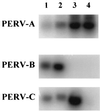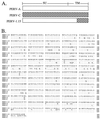Extended analysis of the in vitro tropism of porcine endogenous retrovirus
- PMID: 10590090
- PMCID: PMC111512
- DOI: 10.1128/jvi.74.1.49-56.2000
Extended analysis of the in vitro tropism of porcine endogenous retrovirus
Abstract
We previously reported that mitogenic activation of porcine peripheral blood mononuclear cells resulted in production of porcine endogenous retrovirus(es) (PERV[s]) capable of productively infecting human cells (C. Wilson et al., J. Virol. 72:3082-3087, 1998). We now extend that analysis to show that additional passage of isolated virus, named here PERV-NIH, through a human cell line yielded a viral population with a higher titer of infectious virus on human cells than the initial isolate. We show that in a single additional passage on a human cell line, the increase in infectivity for human cells is accounted for by selection against variants carrying pig-tropic envelope sequences (PERV-C) as well as by enrichment for replication-competent genomes. Sequence analysis of the envelope cDNA present in virions demonstrated that the envelope sequence of PERV-NIH is related to but distinct from previously reported PERV envelopes. The in vitro host range of PERV was studied in human primary cells and cell lines, as well as in cell lines from nonhuman primate and other species. This analysis reveals three patterns of susceptibility to infection among these host cells: (i) cells are resistant to infection in our assay; (ii) cells are infected by virus, as viral RNA is detected in the supernatant by reverse transcription-PCR, but the cells are not permissive to productive replication and spread; and (iii) cells are permissive to low-level productive replication. Certain cell lines were permissive for efficient productive infection and spread. These results may prove useful in designing appropriate animal models to assess the in vivo infectivity properties of PERV.
Figures



Similar articles
-
Detailed mapping of determinants within the porcine endogenous retrovirus envelope surface unit identifies critical residues for human cell infection within the proline-rich region.J Virol. 2012 Sep;86(17):9096-104. doi: 10.1128/JVI.00738-12. Epub 2012 Jun 13. J Virol. 2012. PMID: 22696659 Free PMC article.
-
Comparison of porcine endogenous retroviruses infectious potential in supernatants of producer cells and in cocultures.Xenotransplantation. 2014 Mar-Apr;21(2):162-73. doi: 10.1111/xen.12081. Epub 2014 Jan 21. Xenotransplantation. 2014. PMID: 24447212
-
Identification of residues outside of the receptor binding domain that influence the infectivity and tropism of porcine endogenous retrovirus.J Virol. 2008 Aug;82(15):7483-91. doi: 10.1128/JVI.00295-08. Epub 2008 May 28. J Virol. 2008. PMID: 18508891 Free PMC article.
-
The International Xenotransplantation Association consensus statement on conditions for undertaking clinical trials of porcine islet products in type 1 diabetes--chapter 5: Strategies to prevent transmission of porcine endogenous retroviruses.Xenotransplantation. 2009 Jul-Aug;16(4):239-48. doi: 10.1111/j.1399-3089.2009.00544.x. Xenotransplantation. 2009. PMID: 19799764
-
How Active Are Porcine Endogenous Retroviruses (PERVs)?Viruses. 2016 Aug 3;8(8):215. doi: 10.3390/v8080215. Viruses. 2016. PMID: 27527207 Free PMC article. Review.
Cited by
-
Multiple groups of novel retroviral genomes in pigs and related species.J Virol. 2001 Mar;75(6):2771-5. doi: 10.1128/JVI.75.6.2771-2775.2001. J Virol. 2001. PMID: 11222700 Free PMC article.
-
Transcriptional regulation of porcine endogenous retroviruses released from porcine and infected human cells by heterotrimeric protein complex NF-Y and impact of immunosuppressive drugs.J Virol. 2002 Dec;76(24):12553-63. doi: 10.1128/jvi.76.24.12553-12563.2002. J Virol. 2002. PMID: 12438581 Free PMC article.
-
Infection barriers to successful xenotransplantation focusing on porcine endogenous retroviruses.Clin Microbiol Rev. 2012 Apr;25(2):318-43. doi: 10.1128/CMR.05011-11. Clin Microbiol Rev. 2012. PMID: 22491774 Free PMC article. Review.
-
Study of full-length porcine endogenous retrovirus genomes with envelope gene polymorphism in a specific-pathogen-free Large White swine herd.J Virol. 2000 Sep;74(18):8575-81. doi: 10.1128/jvi.74.18.8575-8581.2000. J Virol. 2000. PMID: 10954559 Free PMC article.
-
Isolation of an Ecotropic Porcine Endogenous Retrovirus PERV-C from a Yucatan SLAD/D Inbred Miniature Swine.J Virol. 2023 Mar 30;97(3):e0006223. doi: 10.1128/jvi.00062-23. Epub 2023 Mar 8. J Virol. 2023. PMID: 36883860 Free PMC article.
References
-
- Armstrong J A, Porterfield J S, Madrid A T D. C-type virus particles in pig kidney cell lines. J Gen Virol. 1971;10:195–198. - PubMed
-
- Kawakami T G, Kollias G V, Jr, Holmberg C. Oncogenicity of gibbon type-C myelogenous leukemia virus. Int J Cancer. 1980;25:641–646. - PubMed
-
- Le Tissier P, Stoye J P, Takeuchi Y, Patience C, Weiss R A. Two sets of human-tropic pig retroviruses. Nature. 1997;389:681–682. - PubMed
Publication types
MeSH terms
Substances
LinkOut - more resources
Full Text Sources
Other Literature Sources

